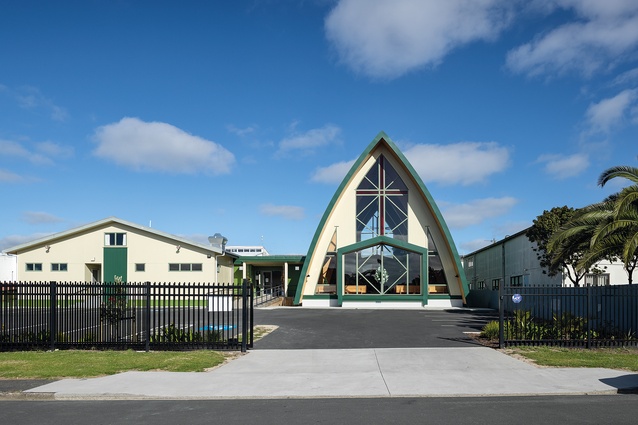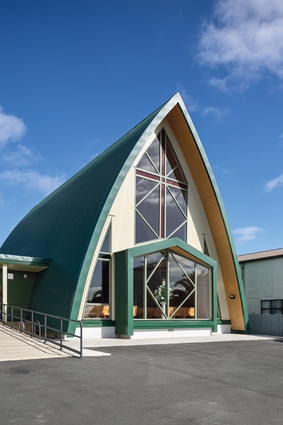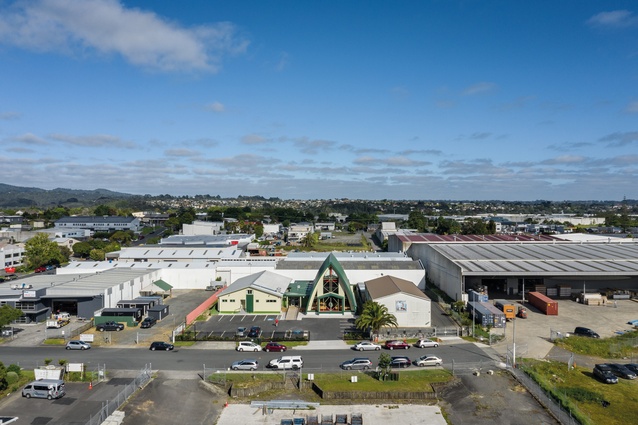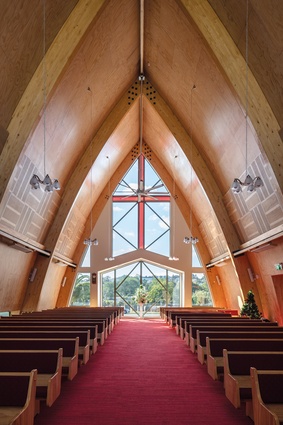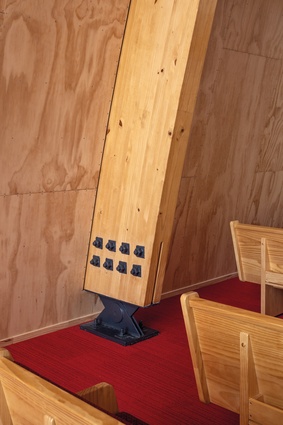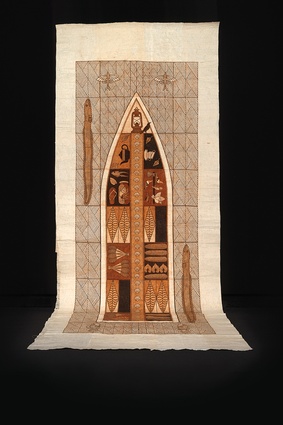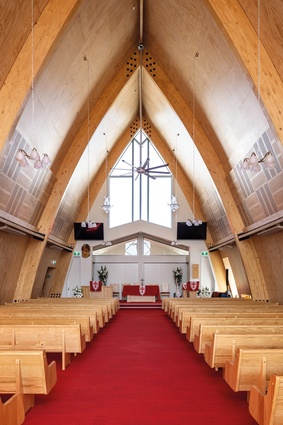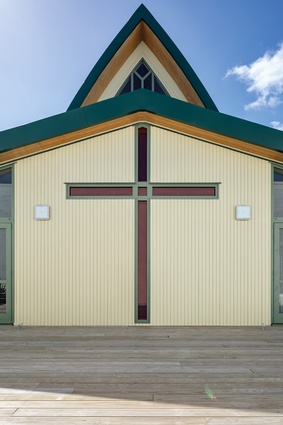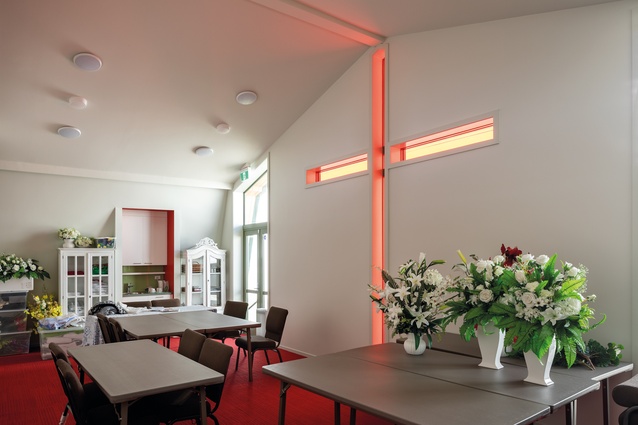A vessel landed on another shore
Bill McKay discusses the arrival of the vaulted Tuvalu Christian Church in Henderson, West Auckland, designed by South Pacific Architecture.
Both my grandfathers had salt water in their veins, traversing the Pacific. Maybe that’s where my love of our ocean and my interest in the vessels and architecture of the region come from. So, the first time I went to this church, it wasn’t a Gothic arch or hands clasped in prayer I saw, it was the bow of a boat or prow of a vaka (canoe is such an inadequate translation).
Maybe this was because I’d just seen Christchurch Art Gallery’s fabulous exhibition Te Wheke: Pathways Across Oceania, full of the inspiring art of young Pacific people. Robin White and Ruha Fifita’s tapa collaboration, We are the Small Axe, takes the same pointed arch form, representing both window and vaka, escorted by eel and flying fish, and loads it with symbols, tipped with a glass lamp. In both that tapa and the new Tuvaluan church by South Pacific Architecture, one can see similar expressions of navigation and connection, sustenance and comfort: all in a spiritual, cultural and physical sense.
The Tuvalu congregation has been here in Aotearoa for about three decades, most members originally settling in West Auckland to be close to fruit-picking work and one another. Several families used a variety of churches and halls but, of course, wished they could be closer to where they lived. They established a hall on this Henderson site at the turn of the century and that has been refurbished as part of this project but, as the number of families grew, the need for a church became even more pressing.
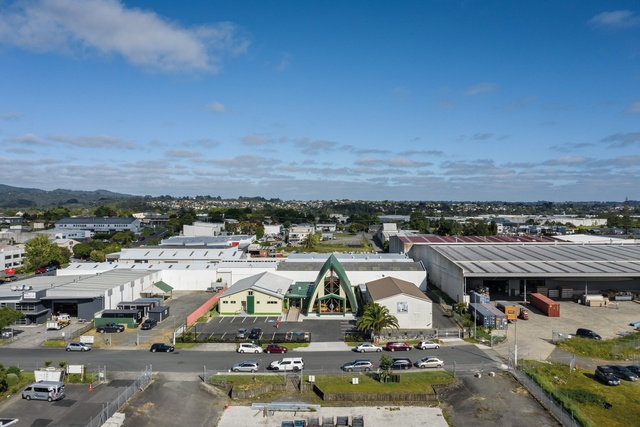
You can see this church from the Sunnyvale train station and it has a striking transparency: a lamp by day and by night. Its graceful, aspirant form wears a cloak of humble corrugated iron and sits on a car park in an industrial street of West Auckland. South Pacific Architecture principal Megan Rule describes the raw industrial location as a rather harsh environment and wanted to bring some warmth and grace to the project to create a space that would draw people in. It certainly does that, as well as allowing you to get away with industrial materials, such as the corrugated cladding. These have a not-of-place simplicity and humility, as well as saving the congregation and community’s money; it is not a fancy door that is the finest greeting at a whare, it’s the warmth of the welcome.
Tuvaluan architectural graduate Ben Kofe, now in Australia, developed an initial feasibility concept more than a decade ago, with the church located on a first floor above carparking. After a lot of fund-raising and a new pastor, Tomasi Iopu, picking up the task, South Pacific Architecture was approached to progress the project and came up with a vaulted form. The architects also went into bat with the Council over the number of car parks needed, as this was pushing up the size of the structure and the cost, when usage was mostly after business hours.
The result is an east-facing church next to the existing hall, all on one level, simplifying circulation and much improving accessibility. The main entrance brings you into a central space with access to hall or church or pastor’s office. It’s also seismic separation between two different structures from different eras. There is a large meeting room tucked behind the altar end of the church, opening out onto a deck, planting and afternoon sun. Its roof is lower than the soaring church vault to allow light through at each end of the main space.
It is the glue-laminated-timber vaulted space that makes this place special. The portals are reminiscent of the ribs of boats and that isn’t coincidental; the boat has long been a Christian symbol, and the term ‘nave’, for the body of a church, is derived from the Latin word for ship. Community response to the building has been strong. It is smaller than was originally envisaged, and this makes it warm and comfortable when you are alone, unlike the echoing emptiness of some churches.
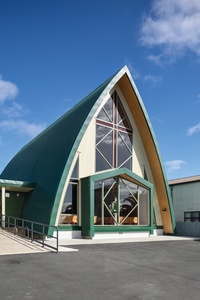
Many of the community drop in now and have described it as “peaceful”, “tranquil” and granting “peace of mind”. During services and on big occasions, it feels comfortably full. The soaring vault and articulated, rather than flat, glazing work very well acoustically, especially with the lively choral singing of both hymns and traditional songs. The architects were very conscious of sustainable aspects of the building, maintenance and the possibility of future expansion.
South Pacific Architecture also assisted with fund-raising and members of the community have provided much; for instance, the women’s society provided chairs, the pulpit and the communion table. More is to come, including planting, more stained glass, and art and cultural works, such as kolose, Tuvaluan crochet. As well as the Christian cross, of course, there are, in the structure and details of the building, important symbols of Tuvaluan culture, such as the green of the cladding and angled mullions forming the diamond patterns that are regularly seen in kolose.
Pastor Tomasi and his wife describe the long journey over decades to make this church and how many of those involved have not survived to see “the dream come true”. “But we did it!” despite the hard voyage to reach this time and place. Materiality is important to Megan Rule, especially to “warm up” an economic structure. The timber reminds many of “home” – but which home is that? Is the embrace of this timber structure an echo of the maneapa, the Tuvaluan meeting house? Tuvalu is one of the smaller groups of islands in the Pacific Ocean and is so low-lying that its people are experiencing the creeping, pervasive effects of global warming: bigger and more-frequent cyclones, rising sea levels, more vulnerability to tsunami and increasing salinity affecting crops, fresh water and homes.
Poor Pacific – Herman Melville called it the “tide-beating heart of earth” that “rolls the midmost waters of the world, the Indian Ocean and Atlantic being but its arms”1. But, on European world maps, it’s mostly chopped in two because northerners think of it as a vast emptiness speckled with isolated islands. It has been colonised, been a global battleground and seen more atomic bombs explode than any other place on the planet. Its deep-sea fish are being plundered, rubbish is being poured in and ciguatera toxins are affecting reef life more and more.
And now, with climate change, its inhabitants will be first to pay the price for the growth and ‘progress’ of its wealthier continental neighbours, both capitalist and communist. “I think one day we’ll disappear,” says Enna Sione,2 thinking not just of the submerging land but of the dilution of identity and culture, as Tuvaluan people are faced with emigration elsewhere.
But, to the people of the Pacific, descendants of voyagers and navigators, the ocean does not isolate islands, it connects them. The ocean is buoyant and bountiful: a place of food, safety sometimes, connection, travel, trade and exchange, and new horizons for new opportunities and settlements. It is easy to move around when you have excellent vessels and know how to navigate by the sun, stars, swells and seabirds.
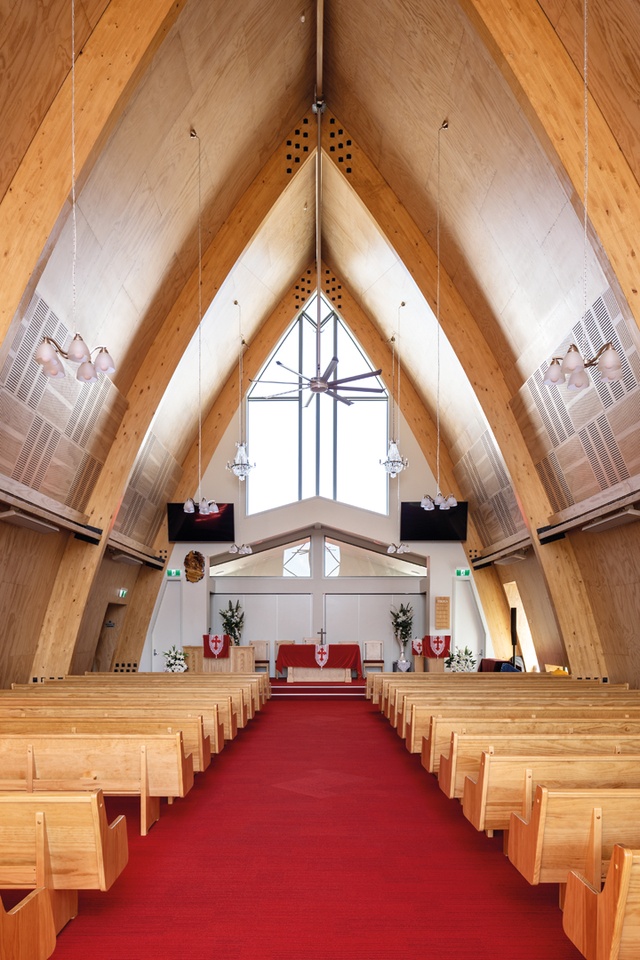
In the words of the great scholar and philosopher of Oceania, Epeli Hau’ofa, “Oceania is vast, Oceania is expanding… Oceania is humanity rising from the depths of brine and regions of fire…”3 Te wheke, the octopus, is a symbol throughout the Pacific of the movement of people, the connection of islands, the expansion of culture. Its body rests where your origin is, your Hawaiki, and its arms are pathways, connections to where you are now. In the intersection of the cross and diamond pattern on the face of this church, I can see the eight arms of te wheke radiating out. Those glulam ribs are also each connected by an octet of bolts to the floor – that octopus again – and, like any vessel, this building is able to rise up and move elsewhere if need be.
Many more Oceanic people will find themselves in New Zealand but it is not a lifeboat; they are not washed up or wrecked here. All of us on our islands here, the last big land mass in the world to be settled, came originally from somewhere else. And I hope that, in its architecture, Auckland, the biggest city in the South Pacific, becomes more representative of its diverse crew.
This church and community centre is not an isolated island in Henderson but a vessel landed here on another shore of Oceania. This is not just a church, one of Christianity’s symbolic boats, but a Tuvaluan vaka as well: a vessel nurturing Tuvaluan community, culture, heritage and coming generations on their voyages to who knows what is next.
Herman Melville, Moby-Dick, Chapter CXI ‘The Pacific’.
Quoted in Eleanor Ainge Roy, ‘One day we’ll disappear: Tuvalu’s sinking islands’,
theguardian.com/global-development/2019/may/16/one-day-disappear-tuvalu-sinking-islands-rising-seas-climate-change
Epeli Hau’ofa, ‘Our sea of islands’, The Contemporary Pacific, 1994, Vol. 6, pp. 148–161.

